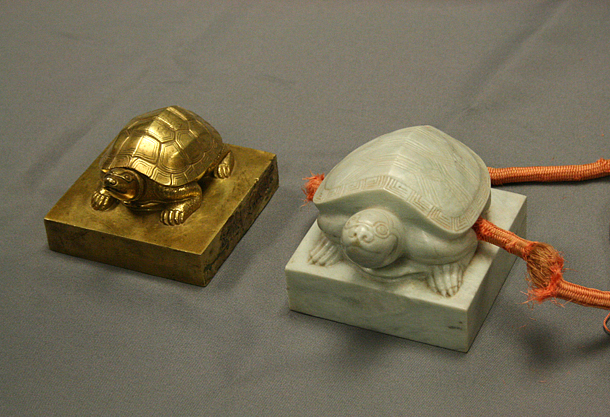President will fly 2 stolen royal seals back from the U.S.

Two Korean royal seals, the Royal Seal of Queen Munjeong, left, and the Royal Seal of King Hyeonjong, right, will be flying in on the presidential plane today, coming home decades after they were illegally taken from the country. [CULTURAL HERITAGE ADMINISTRATION]
The two seals of the Joseon Dynasty (1392-1910) - the Royal Seal of Queen Munjeong and the Royal Seal of King Hyeonjong - will be coming home aboard the presidential plane with Moon Jae-in, who heads back to Seoul from his first trip abroad as president on Saturday.
According to the Cultural Heritage Administration (CHA), a ceremony to transfer the royal seals, or eobo, was held at the Korean Embassy in Washington on Friday at 11 a.m. local time. In early June, the CHA announced that it had completed all procedures to bring back the two eobo with the U.S. Immigration and Customs Enforcement.
The eobo are presumed to have been illegally carried out of the country during the Korean War. The Royal Seal of Queen Munjeong, a gilt bronze seal that was made in the second year of King Myeongjong in 1574 to honor Queen Munjeong (1501-1565), was rediscovered when the Los Angeles County Museum of Art acquired it from Los Angeles-based collector and dealer Robert Moore in 2000. CHA said it reported the Royal Seal of Queen Munjeong as stolen to the U.S. Department of Homeland Security in May 2013 and requested a formal investigation into the matter.
The discovery of the Royal Seal of King Hyeonjong was a happy accident. Local broadcaster KBS visited Moore to film a documentary about the Royal Seal of Queen Munjeong and found the Royal Seal of King Hyeonjong in Moore’s possession. CHA said it only learned of its existence when KBS broadcast its report.
“It has not been made official, but as we understand it, Moore obtained the two seals at an auction in Japan and took them to the United States,” said an official from CHA. “Since we never sold the royal seals, we regard all lost royal seals as stolen.” But details on how the seals left Korea are unclear, the official added.
CHA requested another investigation into the Royal Seal of King Hyeonjong in July 2013 from the U.S. Department of Homeland Security. It seized the two seals in September 2013.
Both seals have on top a realistic depiction of a turtle, an animal that usually represents longevity. The Royal Seal of Queen Munjeong is made of gold while the Royal Seal of King Hyeonjong is made of jade.
Eobo are royal seals that were used to represent the king’s official approval. They differ from gugsae, national seals, which were stamped on diplomatic or administrative documents. According to CHA, about 37 national seals and 375 royal seals are believed to have been made during the Joseon Dynasty and the Korean Empire. A majority were stolen during the Korean War. Four stolen state seals and seven royal seals have been repatriated to Korea.
When the two eobo make it back to Korea, CHA said it will show them to the public at a special exhibition at the National Palace Museum of Korea, possibly in August.
BY YIM SEUNG-HYE [sharon@joongang.co.kr]










with the Korea JoongAng Daily
To write comments, please log in to one of the accounts.
Standards Board Policy (0/250자)